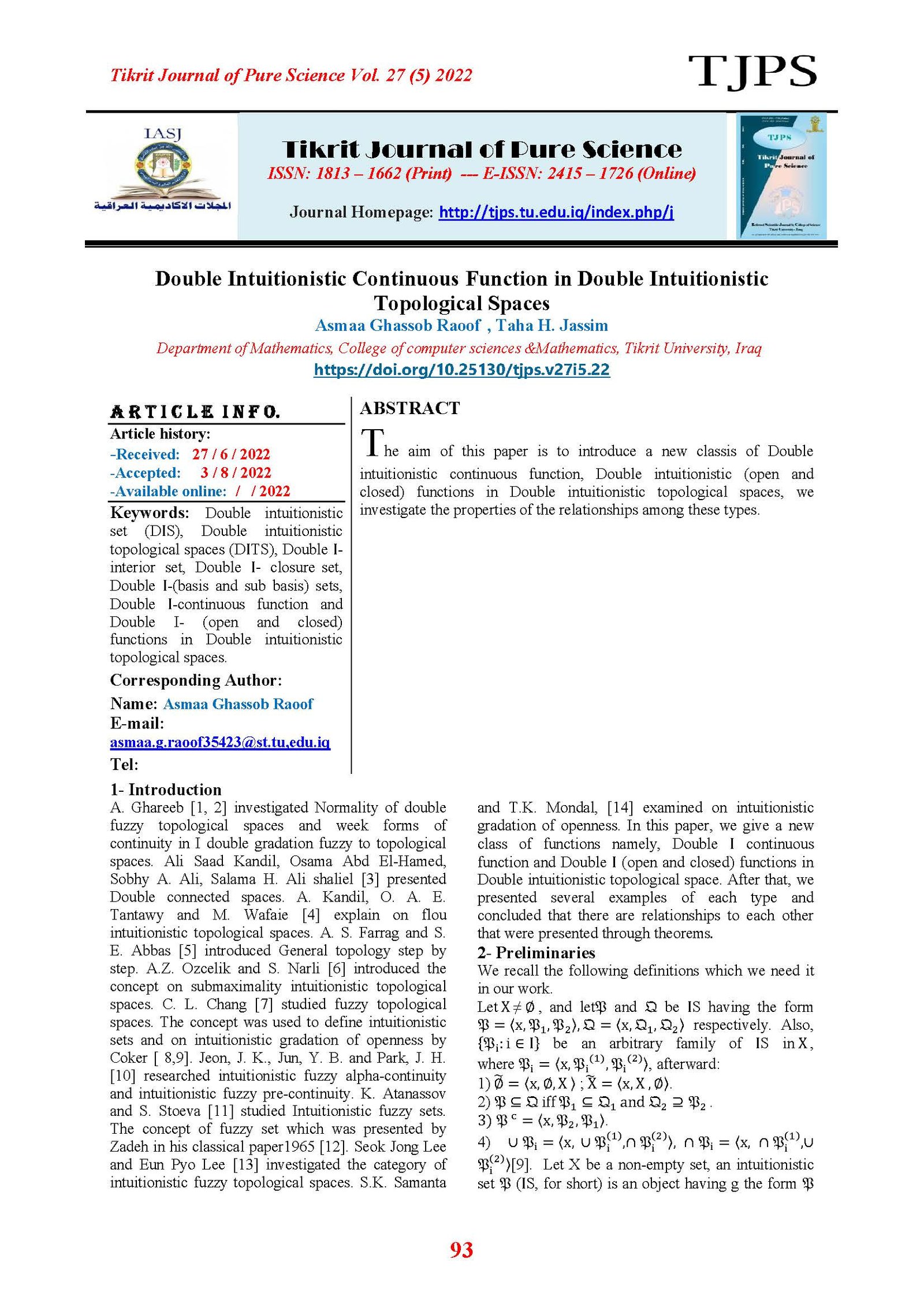Double Intuitionistic Continuous Function in Double Intuitionistic Topological Spaces
Main Article Content
Abstract
The aim of this paper is to introduce a new classis of Double intuitionistic continuous function, Double intuitionistic (open and closed) functions in Double intuitionistic topological spaces, we investigate the properties of the relationships among these types.
Article Details

This work is licensed under a Creative Commons Attribution 4.0 International License.
Tikrit Journal of Pure Science is licensed under the Creative Commons Attribution 4.0 International License, which allows users to copy, create extracts, abstracts, and new works from the article, alter and revise the article, and make commercial use of the article (including reuse and/or resale of the article by commercial entities), provided the user gives appropriate credit (with a link to the formal publication through the relevant DOI), provides a link to the license, indicates if changes were made, and the licensor is not represented as endorsing the use made of the work. The authors hold the copyright for their published work on the Tikrit J. Pure Sci. website, while Tikrit J. Pure Sci. is responsible for appreciate citation of their work, which is released under CC-BY-4.0, enabling the unrestricted use, distribution, and reproduction of an article in any medium, provided that the original work is properly cited.
References
[1] A. Ghareeb, (2011) "Normality of double fuzzy topological spaces" Applied Mathematics Letters, Vol. 24, No. 4, pp. 533–540.
[2] A. Ghareeb, (2012) "Week forms of continuity in I double gradation fuzzy to topological spaces" Springer Plus, Vol.19, No.1, pp.1-9.
[3] A. S. Kandil, O. A. El-Hamed, S. A. Ali and S. H. A. Shaliel, (2017) "Double connected spaces" Issn: 2149 -1402, J. of New Theory, 17, pp. 1-17.
[4] A. Kandil, O. A. E. Tantawy and M. Wafaie, (2007) "On flou intuitionistic topological spaces" J. Fuzzy Math. 15 (2), pp. 1−23.
[5] A. S. Farrag and S. E. Abbas, (2019) "General topology step by step" Book, pp. 1-300.
[6] A.Z. Ozcelik and S. Narli, (2007) “On submaximality intuitionistic topological spaces” Int.J. of Math., and Math. Sci.Vol. 1, No. 1, Issn, pp. 139-141.
[7] C. L. Chang, (1968) "Fuzzy topological spaces", J. Math. Anal. Appl., 24, pp. 182-190.
[8] D. Coker, (2000) "An introduction to intuitionistic topological spaces" Bsefal 81, pp. 51-56.
[9] D. Coker, (1996) “A note on intuitionistic sets and intuitionistic points” Tr. J. of Math. 20, pp.343-351.
[10] J. K. Jeon, Y. B. Jun and J. H. Park, (2005) “Intuitionistic fuzzy alpha-continuity and intuitionistic fuzzy pre-continuity” Int. J. of Math. And Math. Sci. 19, pp. 3091-3101.
[11] K. Atanassov and S. Stoeva, (1983) "Intuitionistic fuzzy sets" In Procceding of The Polish Synposium on Int. And Fuzzy Math. Poznan August, pp. 23−26.
[12] L. A. Zadeh, (1965) “Fuzzy sets” Information and Control, J. Math. Anal. App. 8, pp. 338-353.
[13] S. J. Lee and E. P. Lee, (2000) "The category of intuitionistic fuzzy topological spaces" Bull. Korean Math. Soc. 37, No. 1, pp. 63-76.
[14] S.K. Samanta and T.K. Mondal, (2002) "On intuitionistic gradation of openness" fuzzy sets and system 131, pp. 323-336.
